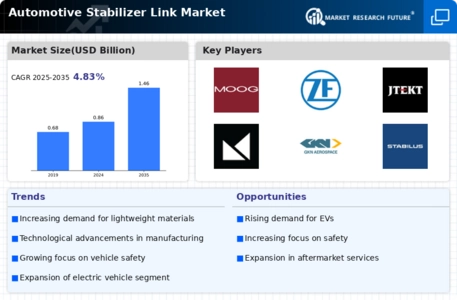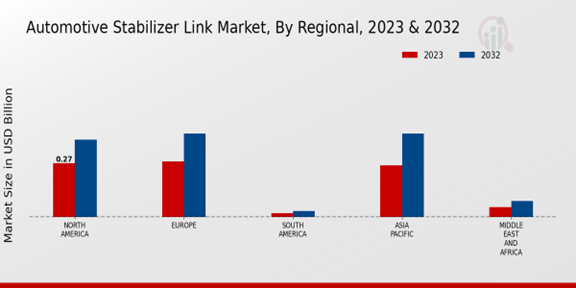Market Growth Projections
The Global Automotive Stabilizer Link Market Industry is poised for substantial growth in the coming years. With a market valuation of 0.86 USD Billion in 2024, projections suggest an increase to 1.46 USD Billion by 2035. This growth trajectory indicates a compound annual growth rate of 4.91% from 2025 to 2035. Such projections reflect the increasing demand for stabilizer links driven by factors such as rising vehicle production, technological advancements, and heightened safety awareness. The market's expansion underscores the critical role of stabilizer links in enhancing vehicle performance and safety, positioning the industry for a promising future.
Increasing Vehicle Production
The Global Automotive Stabilizer Link Market Industry experiences growth driven by the rising production of vehicles worldwide. As manufacturers ramp up production to meet consumer demand, the need for stabilizer links becomes more pronounced. In 2024, the market is valued at 0.86 USD Billion, reflecting the essential role of stabilizer links in enhancing vehicle stability and safety. This trend is likely to continue as global vehicle production is projected to increase, thereby boosting the demand for automotive components, including stabilizer links. The anticipated growth in vehicle production suggests a robust future for the Global Automotive Stabilizer Link Market Industry.
Growing Awareness of Vehicle Safety
The increasing emphasis on vehicle safety significantly influences the Global Automotive Stabilizer Link Market Industry. Consumers are becoming more aware of the importance of vehicle stability and handling, which directly correlates with the performance of stabilizer links. As a result, manufacturers are prioritizing the integration of high-quality stabilizer links in their vehicles to meet safety standards and consumer expectations. This heightened focus on safety is likely to drive market growth, as consumers are willing to invest in vehicles equipped with superior safety features. The market's growth is indicative of a broader trend towards enhanced vehicle safety in the automotive industry.
Regulatory Standards and Compliance
Regulatory frameworks governing vehicle safety and emissions are pivotal in shaping the Global Automotive Stabilizer Link Market Industry. Governments worldwide are implementing stringent regulations that require manufacturers to enhance vehicle stability and safety features. Compliance with these regulations necessitates the incorporation of high-quality stabilizer links in vehicle designs. As these standards become more rigorous, the demand for reliable and effective stabilizer links is expected to increase. This regulatory push not only supports market growth but also encourages innovation within the industry, ensuring that manufacturers remain competitive in a rapidly evolving landscape.
Expansion of Electric Vehicle Market
The rise of electric vehicles (EVs) presents a unique opportunity for the Global Automotive Stabilizer Link Market Industry. As the automotive sector shifts towards electrification, the demand for stabilizer links in EVs is anticipated to grow. Electric vehicles require advanced suspension systems to accommodate their unique weight distribution and handling characteristics. Consequently, manufacturers are likely to invest in high-performance stabilizer links tailored for EV applications. This trend aligns with the overall market growth, with projections indicating a compound annual growth rate of 4.91% from 2025 to 2035, highlighting the potential for stabilizer links in the evolving automotive landscape.
Technological Advancements in Automotive Components
Technological innovations play a crucial role in shaping the Global Automotive Stabilizer Link Market Industry. The introduction of advanced materials and manufacturing processes enhances the performance and durability of stabilizer links. For instance, the use of lightweight materials contributes to improved fuel efficiency and vehicle handling. As automotive manufacturers increasingly adopt these technologies, the demand for high-quality stabilizer links is expected to rise. This trend aligns with the overall growth trajectory of the market, which is projected to reach 1.46 USD Billion by 2035, indicating a strong correlation between technological advancements and market expansion.

























Leave a Comment